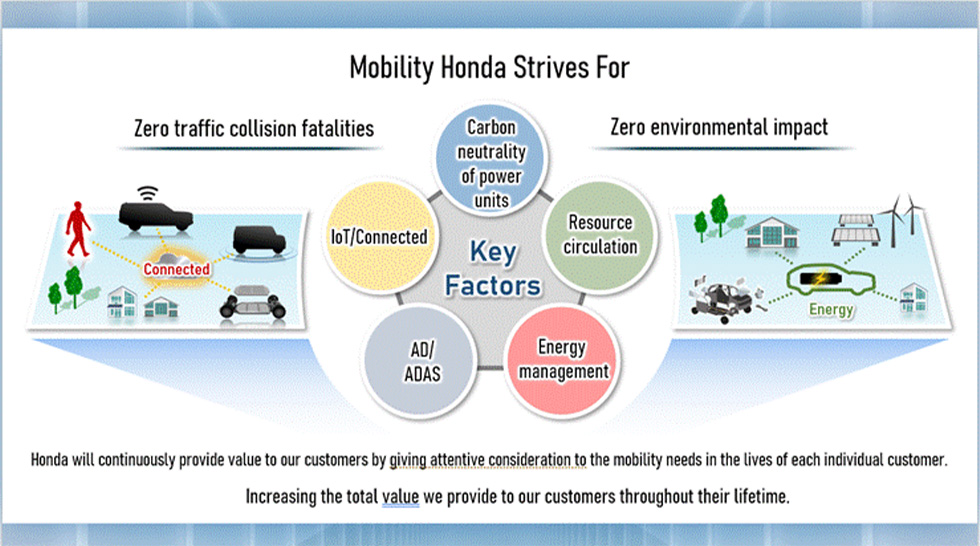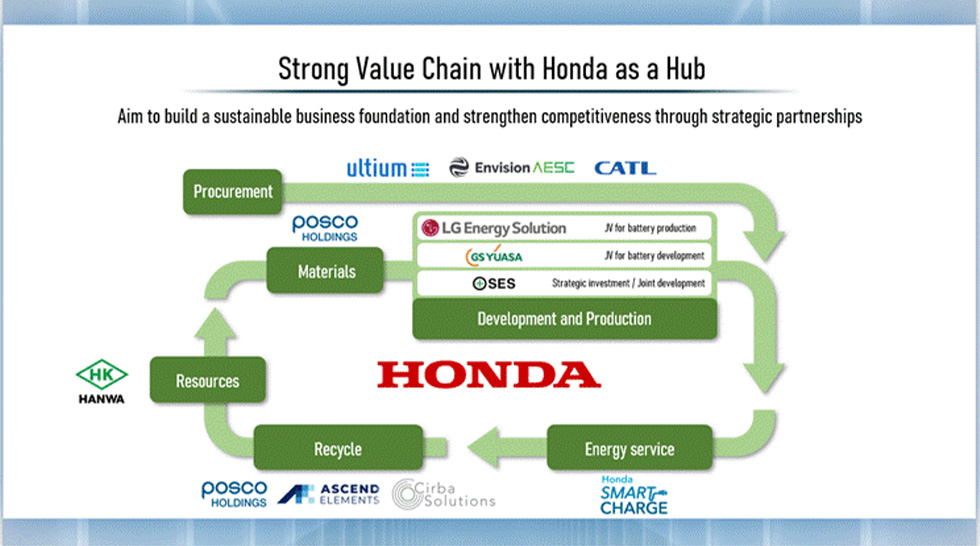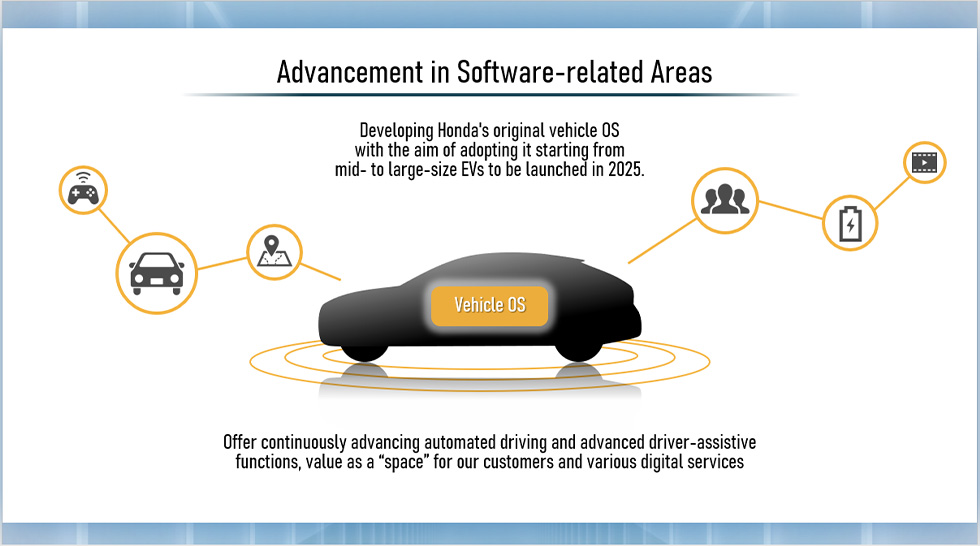Summary of 2023 Honda Business Briefing
– Honda’s corporate transformation initiatives including electrification –
- Improvement of the earnings structure for automobile business:
The amount of fixed costs for FY2023 (fiscal year ended March 31, 2023) was reduced by more than 10% compared to FY2019. The break-even point for FY2023 based on the percentage of production capacity utilization was roughly 80%, an improvement from roughly 90% in FY2019. Honda will strive to make a continuous recovery in sales and achieve a return on sales (ROS) of 7%, which has been Honda’s FY2026 company-wide management target. - Stable procurement of semiconductors:
From a medium- to long-term perspective, Honda has been building cooperative relationships with semiconductor manufacturers, including the strategic collaboration with Taiwan Semiconductor Manufacturing Company Limited (TSMC). - ・Initiatives in battery-related areas:
Toward the achievement of its goal to increase the ratio of EV and FCEV sales to 100% globally by 2040, Honda will continue working on the procurement and development of batteries, as well as securing stable procurement of battery materials by building strong partnerships with resource recycling businesses. - EV introduction plans:
In North America, a mid- to large-size EV model based on Honda’s original dedicated EV platform will go on sale in 2025. In Japan, an EV model based on the N-ONE will go on sale in 2025, and two small-size EV models, including a SUV type, will go on sale in 2026. - Strengthening of software-related areas:
Hona will double the originally planned number of new hires in software-related areas. Honda newly created the Global User Experience (UX) Officer position. - New value creation:
Honda has secured an annual budget at the 100 billion yen level for research into next-generation mobility as well as for fundamental research activities. Honda Innovations Co., Ltd. was newly established this month in Japan to strengthen open innovation with startups.
Japan, April 26, 2023 – Honda Motor Co., Ltd. today held a press briefing on the progress it has achieved toward its business transformation and electrification. The Honda executives presenting at the event included the following:
- Toshihiro Mibe, Director, President and Representative Executive Officer
- Shinji Aoyama, Director, Executive Vice President and Representative Executive Officer
A summary of the briefing follows:
1. Five Key Factors Honda is focused on
Honda strives to realize the joy and freedom of mobility for people around the world with zero environmental impact and zero traffic collision fatalities involving Honda motorcycles and automobiles. In so doing, Honda wants to be a company that serves as a driving force for many people to realize their dreams and move our society forward. To achieve this challenging goal, Honda has been strengthening its business structure and will focus on the following areas, which Honda identifies as the five key factors for the advancement of mobility.
1) Carbon neutrality of power units
2) Energy management system that enables the use of power units as an energy source
3) Resource circulation
4) AD (automated driving)/ADAS (advanced driver-assistance system)
5) IoT (Internet of Things)/Connected

2. Strengthening of Business Structure
<Improvement of the earnings structure>
Honda has made steady improvement of its earnings structure for automobile business over the last several years by implementing various measures including the introduction of Honda Architecture and a “series planning” system for new models, reduction of the total number of variations at the trim and option level for global models and optimization of production capacity. For FY2023 (fiscal year ended March 31, 2023), the amount of fixed costs was reduced by more than 10% compared to FY2019, and the break-even point based on the percentage of production capacity utilization was roughly 80%, a significant improvement from roughly 90% in FY2019.
Moreover, due partly to the contribution of motorcycle business, which has established a strong earnings structure, Honda has been able to secure a sufficient level of free cash flow despite the tough business environment. Going forward, Honda will aim to achieve a return on sales (ROS) of 7%, which has been Honda’s FY2026 company-wide management target, by steadily recovering its automobile unit sales volume.
<Actions to address semiconductor shortage>
Concerning the ongoing shortage of semiconductors, Honda has been taking various actions to deliver products to its customers as soon as possible by implementing measures from both short-term and medium- to long-term perspectives.
1) Short-term measures:
In addition to further strengthening relationships with suppliers, Honda is taking various measures including dual-sourcing of key parts and the development of alternative parts.
2) Medium- to long-term measures:
While enhancing its risk-sensing measures, Honda has been building cooperative relationships and enhancing collaboration with semiconductor manufacturers, including the strategic collaboration with TSMC, through which Honda strives to ensure stable procurement of semiconductors.
3. Direction of Electrification Business
<Motorcycle business>
Honda plans to introduce 10 or more electric motorcycle models globally by 2025 and aims to increase annual sales of electric models to 3.5 million units, equivalent to approximately 15% of total unit sales, as of 2030.
- Honda will launch the EM1 e: electric scooter equipped with a Honda Mobile Power Pack e: swappable battery in Japan, Europe and Indonesia before the end of 2023.
- Envisioning the future business environment, market uses and technological advancements, Honda is exploring a range of future models including those equipped with a power source other than swappable batteries.
<Automobile business>
Honda has set a goal to increase the ratio of EV and FCEV sales to 100% globally by 2040. To this end, Honda is planning to produce more than 2 million EVs annually by 2030.
Plans for the introduction of EV models are as follows.
・North America:
- In 2024, the Honda Prologue and Acura ZDX, currently being codeveloped with General Motors (GM), will go on sale.
- In 2025, a mid- to large-size EV model which adopts the new E&E architecture based on Honda’s original dedicated EV platform will go on sale.
・China:
- In early 2024, e:NS2 and e:NP2 will go on sale.
- Before the end of 2024, mass production models based on the e:N SUV xù concept model will go on sale. The e:N SUV xù concept model was unveiled at Auto Shanghai this month.
- By 2027, Honda will introduce a total of 10 new EV models, including three models mentioned above.
- By 2035, Honda will strive to make EVs 100% of its automobile sales in China, ahead of other regions.
・Japan:
- In the first half of 2024, a N-VAN-based commercial-use mini-EV model will go on sales.
- In 2025, an EV model based on the N-ONE will go on sale.
- In 2026, two small-size EV models,will go on sale.
Keeping pace with the enhancement of its EV lineup, Honda will begin offering vehicle charging services. For home recharging, based on the Honda SmartCharge™, an EV charging service currently available in North America, Honda is planning to roll out energy business that utilizes the power supply capability of EVs. For public charging, Honda will work toward the establishment of an EV charging services environment for its customers in collaboration with providers of convenient and reliable charging networks.
4. Initiatives toward Steady Progress in Electrification
To ensure steady progress in electrification, Honda will entered into various strategic partnerships in areas ranging from procurement to resource circulation of batteries and battery resources, and is building a strong value chain with Honda as a hub to establish a sustainable business foundation.

4-1. Battery procurement and development
1) Now and for the current time period:
In each region, Honda has been strengthening its external partnerships in the area of liquid lithium-ion batteries and is now on track to have good prospects for stable procurement of the amount of batteries Honda will need on a global basis.
- North America:
Procurement of Ultium batteries from GM and establishment of a battery production joint venture with LG Energy Solution (LGES)
- China:
Strengthened collaboration with Contemporary Amperex Technology Co., Limited (CATL)
- Japan:
Procurement of batteries for the N-VAN-based commercial-use mini-EV model from Envision AESC
2) From the second half of the 2020s:
In addition to the advancement of liquid lithium-ion batteries, Honda will develop and introduce next-generation batteries such as semi-solid-state and all-solid-state batteries.
- Honda and GS Yuasa International Ltd. (GS Yuasa) will collaborate to develop high-capacity, high-output liquid lithium-ion batteries for EV use.
- Honda will begin operation of a demonstration line for the production of all-solid-state batteries in 2024, aiming to adopt its all-solid-state batteries to models to be introduced to market in the second half of the 2020s.
- Honda invests in and is jointly developing semi-solid-state batteries (lithium-metal secondary batteries) with SES AI Corporation (SES), an EV battery research and development company.

4-2. Battery resource procurement and resource circulation
In the areas of battery resource procurement and resource circulation, Honda will secure its competitive advantages from a long-term perspective by strengthening initiatives through collaboration with various partners.
1) Resource procurement:
By leveraging a strategic partnership with Hanwa Co., Ltd., Honda will ensure stable procurement in the medium to long term, of essential metals such as nickel, cobalt and lithium.
2) Resource circulation:
Honda will stabilize its material procurement and strive to achieve “zero environmental impact” by proactively utilizing recycled resources through strong partnerships with resource recycling businesses, including collaboration with Ascend Elements, Inc. and Cirba Solutions, and a comprehensive partnership with POSCO Holdings Inc.
4-3. Strengthening EV production system and capability
Preparing for the upcoming start of full-fledged EV production, Honda will re-tool three existing Honda plants in Ohio, in the U.S. (two auto plants, the Marysville Auto Plant and East Liberty Auto Plant, and one automobile powertrain plant, the Anna Engine Plant) to establish highly-efficient and highly-flexible production lines and position these plants as Honda’s EV Hub for production in North America.
Moreover, through the establishment of CO2 reduction technologies and the use of 100% clean energy through the utilization of renewable and other energy sources, Honda will make its Automobile Plant of Saitama Factory in Japan Honda's first carbon neutral plant in FY 2026 (fiscal year ending March 31, 2026).
Furthermore, Honda has begun working on the global reform of its production system with an eye toward the production of EV models scheduled to go on sale in the second half of the 2020s. The reform initiatives will focus on the following three perspectives.
- Establishment of production lines which pursue automation and application of intelligent technologies in consideration of future changes in the workforce.
- Establishment of highly efficient factories and supply chains which will enable a shift to EVs in a short period of time.
- Shift to production processes which reduce CO2 emissions to the utmost limit and assume the resource circulation approach.
5. Strengthening of Software-related Areas
Based on the concept of “software-defined mobility,” in which software defines the value of hardware and services, Honda will accelerate software development.
Specifically, Honda is further advancing its E&E architecture and developing Honda’s original vehicle OS with the aim of adopting them starting from the mid- to large-size EVs to be launched in North America in 2025. Based on this vehicle OS, Honda will continue advancing its in-vehicle software to enable the continuous advancement of vehicle functions and services for customers even after the vehicle is purchased.
Moreover, working toward insourcing of software development in the areas of the vehicle OS, automated driving/advanced driver-assistance system (AD/ADAS) and connected vehicles and services, Honda will double the originally planned number of new hires and also further strengthen recruiting of high-level software development experts. Moreover, Honda will accelerate collaboration with partner companies which have strengths in software development, including KPIT Technologies Limited (KPIT). Through such collaboration, Honda and partners will bring together their respective strengths, namely Honda’s control and safety technologies and partners’ software development capabilities, and strive to realize new value that can be created through software.
In the areas of the user experience (UX) and digital services, Honda will continue strengthening development, mainly in North America, by taking various initiatives including the establishment of a new Global User Experience Officer position and proactive approach in recruiting digital experts.

6. Strengthening of Alliance with GM
Honda will further strengthen its alliance with GM. In addition to codeveloping a series of affordable electric vehicles which will go on sale in 2027 and beyond, the two companies will continue exploring a broad range of collaboration which will combine the respective strengths of the two companies and increase competitiveness in the areas of core electrification components.
7. Initiatives toward New Value Creation
Toward new value creation, Honda will make steady progress by constantly securing an annual budget at the level of 100 billion yen for research into next-generation mobility as well as for fundamental research activities, mainly in the areas of carbon neutrality technologies related to the five key factors Honda is focused on, such as the application of intelligence technologies, advancement of batteries, utilization of hydrogen and sustainable materials.
Moreover, in order to realize new value creation more speedily, Honda has allocated an annual investment budget of 10 billion yen and been proactively pursuing open innovation with startups. To date, Honda has invested in startups which have cutting-edge technologies that are highly likely to be needed in the future, such as AI, synthetic fuels, battery recycling and nuclear fusion power generation technologies.
Furthermore, in order to further strengthen its open innovation functions through close coordination with corporate strategies, Honda has newly established Honda Innovations Co., Ltd. in Japan this month, which will serve as the global head office function for Honda’s open innovation activities.
8. Redefining the Honda Global Brand Slogan
For Honda to continue to be viewed as a company society wants to exist in the midst of the period of the “once in a hundred years transformation” of the industry, Honda management determined that the company needs to re-clarify the “raison d’etre” of Honda, what the company really wants to achieve, as well as the “value proposition” of Honda, which exists beyond its business strategies, such as electrification and digitalization. Based on this realization, Honda redefined the existing Honda Global Brand Slogan – The Power of Dreams – by adding a new tagline and three key words.
・How we move you.
The creation of mobility through the dreams of each and every Honda associate will “move” people physically and also “move” people’s hearts.
・Create, Transcend, Augment
Driven by dreams and the intrinsic motivation of each and every person working at Honda, the company will create “the mobility Honda dreams of” to embody the essential value of all mobility products and services – to enable people to transcend the constraints of time and place, and to augment their every possibility. Through the creation of the mobility Honda dreams of, Honda will become “The Power of Dreams” of more and more people. That is how we will move people and society forward.